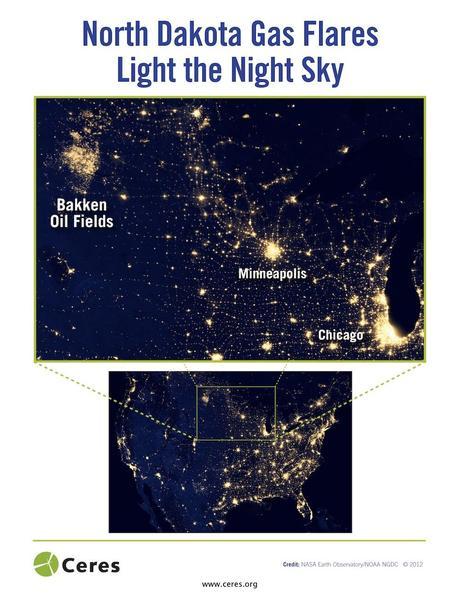Along with a culture of rape and abuse, the increased, “unusually permissive” oil drilling in the Bakken Shale is creating more fossil fuel emissions that you can imagine. Here’s a report by ThinkProgress:
By Kiley Kroh / ThinkProgress
A new report released today by the investor group Ceres found that the unconventional oil boom in North Dakota has led to a dramatic increase in the amount of natural gas that is intentionally burned off, or flared, carrying major economic and environmental consequences. In 2012 alone, flaring resulted in the loss of approximately $1 billion in fuel and greenhouse gas emissions equivalent to adding nearly one million cars to the road.
According to Ceres, nearly 30 percent of North Dakota gas is currently being flared each month as a byproduct of oil production — double the volume of just two years ago. This is due to the fact that at current market rates, oil is approximately 30 times more valuable than natural gas. Therefore, as companies rush to extract oil from the Bakken shale field and cash in on the high price of crude, they have little economic incentive to invest in the infrastructure necessary to capture the gas that bubbles up alongside the oil. So the gas is treated as waste and burned.
Not only is North Dakota wasting enough natural gas each day to heat half a million homes, but the flaring is so widespread that it is now visible from space, with North Dakota starting to rival some of America’s biggest cities in light pollution.

While flaring is less damaging to the environment than directly venting the gas, flares emit a host of dangerous air pollutants. Terry O’Clair, the state Health Department’s air quality director, says the flare emissions in the state’s oil patch continue to fall within acceptable air quality guidelines, but the sharp increase in flaring could have serious implications for the state’s air quality. Over the course of 2012, natural gas flaring in North Dakota emitted 4.5 million metric tons of carbon dioxide, equivalent to the annual emissions of approximately one million cars.
According to Earthworks, the Ventura County Air Pollution Control District in California identified multiple air pollutants that may be released from natural gas flares, including benzene and formaldehyde, and researchers in Canada have measured more than 60 air pollutants downwind of natural gas flares.
Additionally, the Ceres report emphasizes that “because the flares used tend to only partially combust the natural gas, a variety of other hazardous pollutants are generated by the process, including black carbon, another potent driver of climate change with adverse health effects.”
The Bakken boom is unlikely to subside anytime soon — in fact, it hit record production levels in June. In its 2013 Annual Energy Outlook, the U.S. Energy Information Administration’s projected that oil production from the Bakken formation would increase by an additional 40 percent between 2012 and 2020. As oil and gas production in the region continues to skyrocket, addressing the state’s surging rates of flaring will become more pressing.
Demonstrating that it’s possible for industry to significantly reduce flaring in a short amount of time, Continental Resources Inc., the top producer in the Bakken Shale, announced earlier this year that in 2012 the company cut its rate of flaring in half from the previous year and plans to reduce natural gas flaring from its well sites to “as close to zero percent flaring as possible.”
While some North Dakota companies like Continental have taken important steps to curb their use of flaring, the Ceres report projects that current flaring volumes will continue to rise unless a large-scale mitigation effort is undertaken and the state’s “unusually permissive” flaring regulations are addressed.

